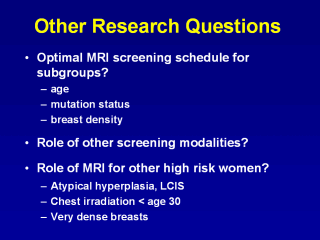 |
Even if we show that MRI improves survival in
the hereditary breast cancer population, there will be many remaining
questions for further research.
At what age should screening MRI begin and end? What is the optimal
frequency? and should this differ according to mutation status or breast
density?
Air bags improve the effectiveness of seatbelts, but how much do
mammography, ultrasound and CBE add to MRI?
And finally, can results from the hereditary risk population automatically
be extrapolated to other high risk populations? I would argue against such
an approach and recommend that theses other groups be specifically studied.
The biological differences between hereditary breast cancers and cancers
arising in other high risk settings may affect the relative sensitivity of
imaging modalities or the benefit of earlier detection.
Some of these questions can probably be answered by meta-analysis of the
results of the studies currently underway. The other questions will only be
answered by future studies with these specific objectives.
 |
Go to Comment Form |
|